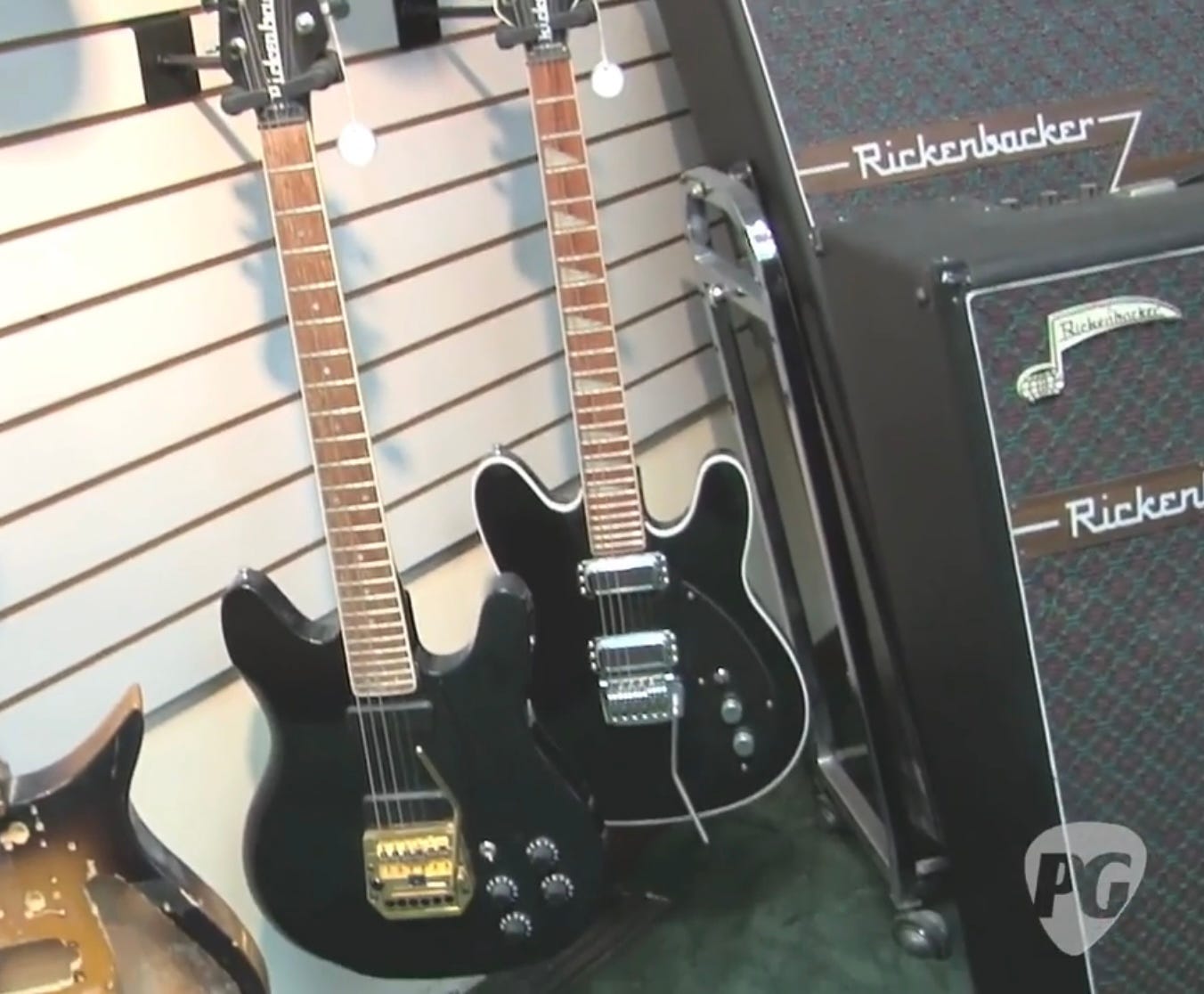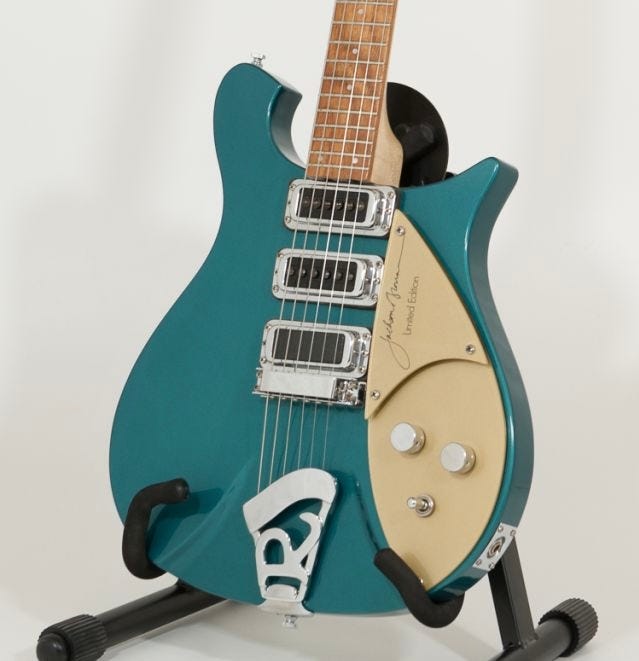Short Takes: The Jackson Browne Signature Limited Edition
You look kinda confused, and that’s fair. I mean, technically there is no Jackson Browne Signature Limited Edition guitar. But there ALMOST was! John Hall worked extensively with Browne to create a guitar that met his unique specs—and several different working prototypes were built to that end—but nothing ever came of it. So let’s talk about what we know about them, and why the model (probably) never hit the market.
First things first: the Signature Limited Edition guitars (which you can read all about here) come in two basic flavors. The first were reproductions of or inspired by specific guitars associated with an artist. Think of the Pete Townshend-inspired 1998PT or the Roger McGuinn-inspired 370/12RM or the Chris Squire-inspired 4001CS. These guitars actually sold.
The other category is composed of brand spanking new guitars developed with an artist to meet their unique specifications—the guitar they had always wished existed, to paraphrase John Hall. Think of the Tom Petty specced 660/12TP or the Susanna Hoffs designed 350SH or the Glenn Frey 230GF. Some of these sold, some not so much.
But it was that category Hall really wanted to make. And there are more unmade guitars out than the Jackson Browne model. Like, say, the Carl Wilson Signature Limited Edition. “But wait,” you say. “There IS a Carl Wilson Signature Limited Edition!” That’s true—but it’s the one his estate approved after his untimely death. The one he was working on with John Hall would have looked something like this:

But we’re not here to talk about those, we’re here to talk about the Jackson Browne guitar. The point is that Hall had a lot of passion for working with artists to build their dream guitars. So let’s discuss what he and Browne, along with sideman extraordinaire Scott Thurston, came up with.
First things first: as already stated, there are multiple versions of this potential Signature Limited Edition, and the details we have are incomplete. Per John Hall there were six (!) pickup/wiring combinations considered, and there have been at least three quite different prototypes identified—although there are two more guitars that appear likely to be Jackson Browne prototypes are currently on display at the factory “showroom/museum”. So let’s talk about what we know. And the best way to do that is to look at them.

We can tell the most about this one because it was sold to (and was lovingly photographed by) collector extraordinaire Graham Griffiths. So here are the elements that appear to be common to all of the known prototypes. We have an unbound 24 fret neck (with a maple fingerboard on this example, but we also have at least one with a rosewood board) and a 400/600 Series style cresting wave body. Unlike most previous 400/600 guitars the construction is set-neck instead of neck through (with a two piece body) and unlike ALL previous 400/600 guitars it features the tailpiece “ramp” found on the 330/360 semi-hollowbodies.

Also note that while most unbound 400/600 guitars have at least some contoured edges, this guitar has a completely flat top and back despite being unbound.

You’ll notice quite different electronics on this prototype. But before we talk about that, there’s something else we should discuss about the construction. She’s thick, boys!

Well, not ridiculously so. More like “330 thick” instead of “620 thick”. And that’s because—due to the set neck—it was constructed like a 330 or a 350 with a separate top and back that sandwich the neck in place. How much—if at all—is the top routed out? I honestly don’t know. But it’s not a traditional Rickenbacker solidbody.
And it’s notable that this guitar—which has 24 frets—was under development at the same time the 24 fret/neck through 650 was being launched, yet that platform was not used for this guitar. Clearly the use of a set neck—which appears to be the 350 Liverpool’s one piece maple neck—and the associated deck height was intentional.

Because the scale is normal Rickenbacker 24 3/4”, the neck has to be longer to accommodate the three extra frets. The bridge was therefore moved further up the body to maintain the scale length. Note how much further away from the R tailpiece the bridge is on the prototypes above when compared to a 21-fret 620.

You see the same difference in bridge location when comparing the 24-fret 350 Liverpool and 21-fret 350V63.
But let’s get back to the wiring. Here’s what we can say with certainty: most had three pickups—with an HB-1 humbucker at the bridge—and all had two knob/one switch wiring with mono output. How did those controls work? Well, there has been at least one replica built by Larry Davis (details of that build can be found here) for a customer who seems to have gotten pretty good inside info on what at least ONE of the possibilities was.

And it’s really quite an interesting setup. So there’s two Higains and an HB-1, but the middle Higain is reverse wound/reverse polarity so it acts like a humbucker in conjunction with the neck pickup. The three way selector allows you to choose between neck and middle in humbucker mode in position one, all three pickups in position two, and neck and bridge in position three. The first knob is a master volume, and the second is a reverse wired volume for the neck pickup—allowing you to roll off the neck pickup in all three positions. That’s a pretty cool setup—and it’s only one of six potentials!
So clearly a lot of thought and work went into the development of this model. So why didn’t it get made? We can’t say for sure…but we can make a pretty good guess. Right around the time the development was going on, Browne and actress Daryl Hannah were divorcing. And in the aftermath of that there were some allegations of abuse—photos circulated, statements were made…but in the end police investigations didn’t find proof and accusations were retracted.
Still, the timing was bad for a Jackson Browne Signature Limited Edition and so the model was shelved. Which is a shame because a lot of effort had been put into it and it’s a truly unique instrument in many different ways—utterly unlike anything before or since. Sadly at this point it falls into the “what might have been” category.

Want to learn more about…everything else? Check out the rickenbacker101 site map and see what’s already been covered! Have a suggestion about what we should tackle next? Drop it in the comments and we’ll add it to the queue.
*


I'd love to see Mr. Hall's list of potential signature models! I like both Browne's and Carl Wilson's prototypes. They look like they would be fun to play and hear.